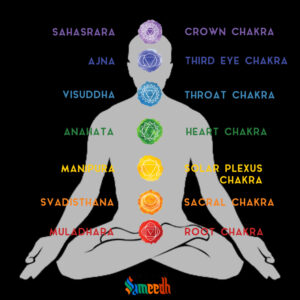The ajna chakra, also known as the third eye chakra, is one of the seven main energy centers in the body according to Hindu and Buddhist teachings. It is located between the eyebrows and is associated with the element of light. The ajna chakra is believed to govern our intuition, perception, and insight.

- Location: Between the eyebrows
- Color: Indigo
- Element: Light
- Significance: Associated with intuition, inner wisdom, and spiritual insight.
- Deity: Ajna is often associated with Ardhanarishvara, a composite form of Shiv and Parvati, symbolizing the union of male and female energies.
The Ajna Chakra, commonly known as the Third Eye Chakra, is the sixth primary chakra in Hinduism in 7 Chakras and is associated with intuition, perception, and spiritual insight.
The Ajna Chakra is located between the eyebrows, slightly above the bridge of the nose. It is often referred to as the “third eye” and is associated with the pineal gland. The traditional color associated with the Ajna Chakra is indigo, a deep blue-purple hue representing wisdom and the opening of the mind.
The element associated with the Ajna Chakra is light. This element is symbolic of insight, clarity, and illumination. The symbol of the Ajna Chakra is often represented by a two-petaled lotus flower, which signifies the duality of perception and the integration of opposites.
The Ajna Chakra is considered the seat of intuition, insight, and higher knowledge. It is associated with inner vision, clarity of thought, and the ability to perceive subtle truths beyond ordinary perception. The concept of the “third eye” is metaphorical and represents an inner vision or perception that goes beyond ordinary sight. It is often described as the eye of wisdom, capable of perceiving deeper truths and spiritual realities.
The Ajna Chakra is commonly associated with Lord Shiv, who is often depicted with a third eye on his forehead. Shiv’s third eye is said to represent spiritual insight and the power of destruction and regeneration.
To balance and open the ajna chakra, some practices that may be helpful include:
Engaging in activities that promote introspection and self-reflection, such as meditation or journaling
Practicing yoga poses that focus on the third eye, such as child’s pose or seated forward bend
Using essential oils or crystals that are associated with the third eye chakra, such as frankincense or amethyst
Visualizing the color indigo or the symbol of the ajna chakra to help bring awareness and energy to this chakra.
The Ajna Chakra is considered a bridge between the lower chakras (associated with earthly concerns) and the higher chakras (associated with spiritual consciousness). Its activation is crucial for the overall balance and harmonious functioning of the chakra system.
Balancing the Ajna Chakra is seen as essential for spiritual growth, clarity of thought, and the development of heightened awareness. It plays a significant role in the journey towards self-realization and higher states of consciousness.
